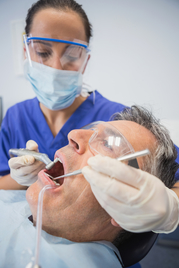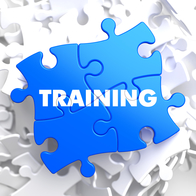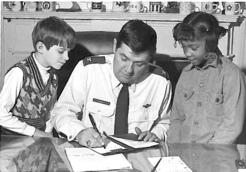|
Winter 2017

 One dental rule concerning diagnostic casts (WF# 16-34 ) is under consideration in the 2017 OHCA permanent rulemaking session. Permanent rule recommendations go to the Legislature and Governor for action in the spring.
Proposed revisions add language to allow dental providers the option to submit the diagnostic cast or photographic images as evidence of medical necessity for dental services. The procedure is a necessary part of many dental practices, including orthodontics, and the change allows providers to bill for a necessary service.
WF# 16-34 is available for comment at www.okhca.org/PolicyBlog. The comment period closes Feb. 17, 2017. We encourage you to review this and other OHCA proposed rules and give your input.
As required by state statute, OHCA provides a Rule Impact Summary for each proposed rule, which includes projected budget impacts.
Back to top
|

 Systematized Nomenclature of Dentistry (SNODENT) is a vocabulary designed by the American Dental Association (ADA) for use in electronic health and dental records (EHR and EDR, respectively).
Initial development of SNODENT began more than 10 years ago. Developed specifically for use with EHRs, SNODENT allows for the capture and analysis of detailed oral health data. You may have noticed that claim forms have a box for diagnosis codes. Now you know the rest of the story.
According to the ADA, the intended purpose of SNODENT is to:
• provide standardized terms for describing dental disease
• capture clinical detail and patient characteristics
• permit analysis of patient care services and outcomes
• be interoperable with EHR and EDR
• better communication among dentists and other health care providers
• improve patient care through evidence-based practices
• enhance data collection for the evaluation of oral care outcomes
The ADA reports that SNODENT enables clinicians to record finely-detailed oral health data in a manner that is on par with our medical colleagues. Eligible dental practitioners who participate in Medicaid may be required to use SNODENT, as SNOMED-CT is the required terminology for certified EHRs.
EHR systems certified under meaningful use Stage 2 criteria can already support use of SNOMED. The ADA is developing a crosswalk from SNODENT to ICD-10 CM. SoonerCare Dental has already provided a targeted list of ICD-10 codes for your education on our website, under “Commonly Used Forms.”
While some dentists may see this advance as “intervention,” it is apparent that diagnosis codes and value-based dental services are near. Dentistry must keep pace with changes, and practitioners should accept this future or be left behind.
More information about SNODENT is available on the ADA website.
Dr. Leon Bragg
Chief Dental Officer
Back to top
|

February is National Children's Dental Health Month and is a great time for all children to have their teeth examined, whether they are covered by SoonerCare, are underinsured ... or have no dental insurance at all.
Below are some community resources to help get it done!
 Get ready for the Oklahoma Mission of Mercy (OkMOM) event, Feb. 3-4, 2017, at the Woodward County Fairgrounds & Event Center. OkMOM is a two-day, FREE dental clinic for adults and children who are either uninsured, under-insured or would normally not have access to dental care. No-cost dental screenings help these patients identify their needs and determine a treatment plan.
This annual event provides dental care to as many people as time, volunteers and supplies will allow. To learn how to volunteer, donate or for more information, please visit OkMOM online at http://www.okmom.org/.
Since 2010, OkMOM has treated 12,175 patients, totaling $8,742,959 in donated dental care.
This event is endorsed by the Oklahoma State Department of Health.
|
Good Shepherd Ministries offers dental and medical care to the uninsured. Dental services tailored specifically for children are available each week, and a number of these timeslots go unfilled.
The Good Shepherd Ministries’ Kids Clinic occurs on Tuesday evenings during the school year . The clinic is located at 222 NW 12th Street in Oklahoma City, at the corner of 12th and Harvey. Volunteer dental students and faculty from OU College of Dentistry provide dental treatment at no charge for any dentally uninsured child with an appointment.
For more information or to schedule an appointment, please call 405-232-8631.
Back to top
 
The American Dental Association (ADA) Code Maintenance Committee has approved 11 new codes for 2017. The new codes will appear in the CDT 2017 Dental Procedure Codes. Among the 11 new codes is D1575, distal shoe space maintainer - fixed-unilateral. The distal shoe has previously been reported as D1510 - space maintainer - fixed-unilateral, which also describes the band and loop space maintainer.
The distal shoe space maintainer is indicated when there is early loss of a primary second molar before the eruption of the first permanent molar. It serves to guide the unerupted permanent first molar into position, preventing mesial movement of the permanent first molar after premature loss or extraction of the second primary molar. OHCA began covering D1575 for our pediatric members on Jan. 1, 2017, and will be reimbursed the same as D1510.
Back to top
 You and your staff are invited to attend the spring 2017 SoonerCare Provider Training Workshops hosted by OHCA and HP Enterprise Services.
- Lawton - April 13
- Durant - April 27
- Tulsa - May 17 - 18
- OKC - May 24 - 25
- Guymon - June 21
OHCA and HP highly recommend that all providers attend this workshop. Be sure to mark your calendar!
We will release class descriptions, recommended audiences and registration details soon. Please visit the provider training page of our website for updates.
Back to top
|

 Many children
have a fear of going to the dentist, but being in a dentist’s office was the
norm for young Debra Bartlett, now a staff member in the Member Services
department at OHCA.
Debra’s
father, Leo Phis Webster, was a dental hygienist at Scott Air Force Base in
Illinois.
One day, in
the mid-1970s, there was a call for two children to help promote a Dental Health
Week. Mr. Bartlett selected his daughter to participate, allowing her to be
part of a photo opportunity with the base commander. This simple turn of events
would impact American children for decades to come.
“I was one of
the first kids to have my teeth sealed,” Debra said. “It was part of a pilot
program, so they can [sic] track us
and see how well the sealants worked.”
|

It was an important moment in the early movement for better dental health in the United States. According to Leo Webster, Dental Health Week was a big thing for the base every year.
“We’d go out to the schools and educate the kids on dental hygiene,” Leo said. “Being that I was so involved with it, they wanted someone to highlight [the week] in the local news media. So, I chose my daughter and my coworker’s son.”
Prior to this time, there was not much instruction available on how to care for teeth. Studies showed that if you taught people how to brush and care for their teeth, it saved them money on dental care and lead to better oral health overall, Leo said. The field was called “preventive dentistry” at that time.
Leo Webster retired after 24 years in the Air Force and now resides in Oklahoma City.
Back to top

OHCA Provider Helpline: 800-522-0114
Dental Prior Authorization Unit: 405-522-7401
|